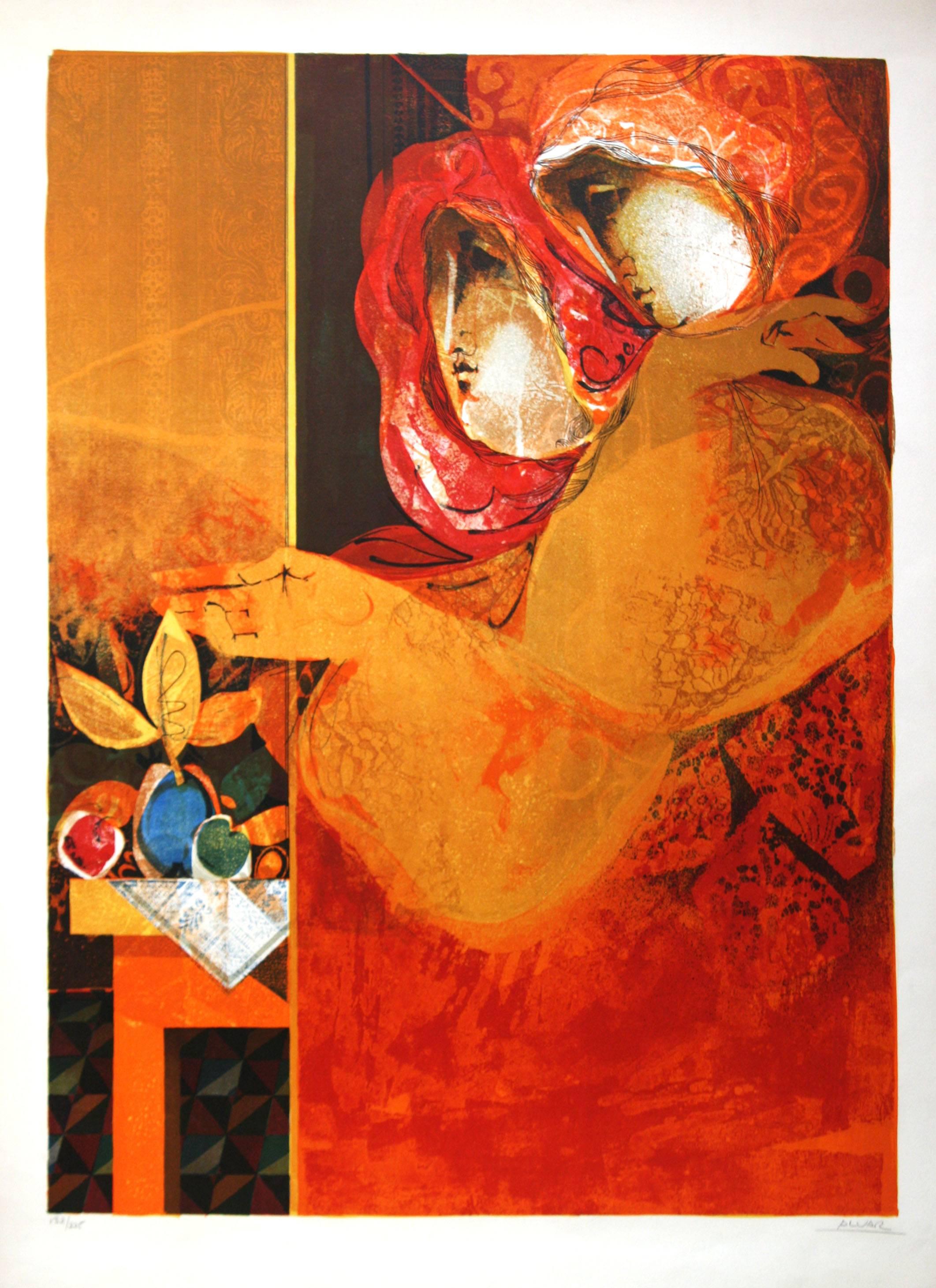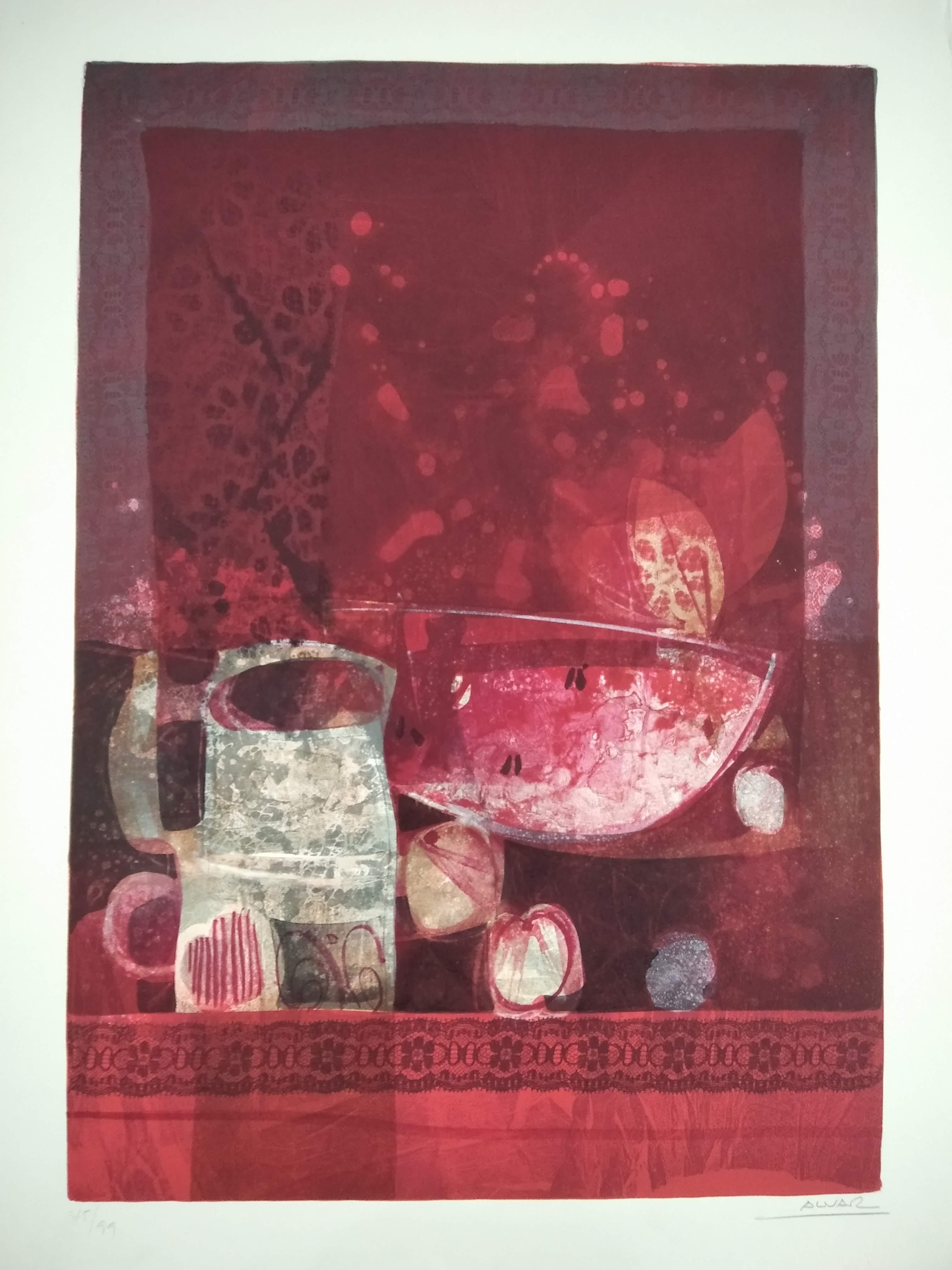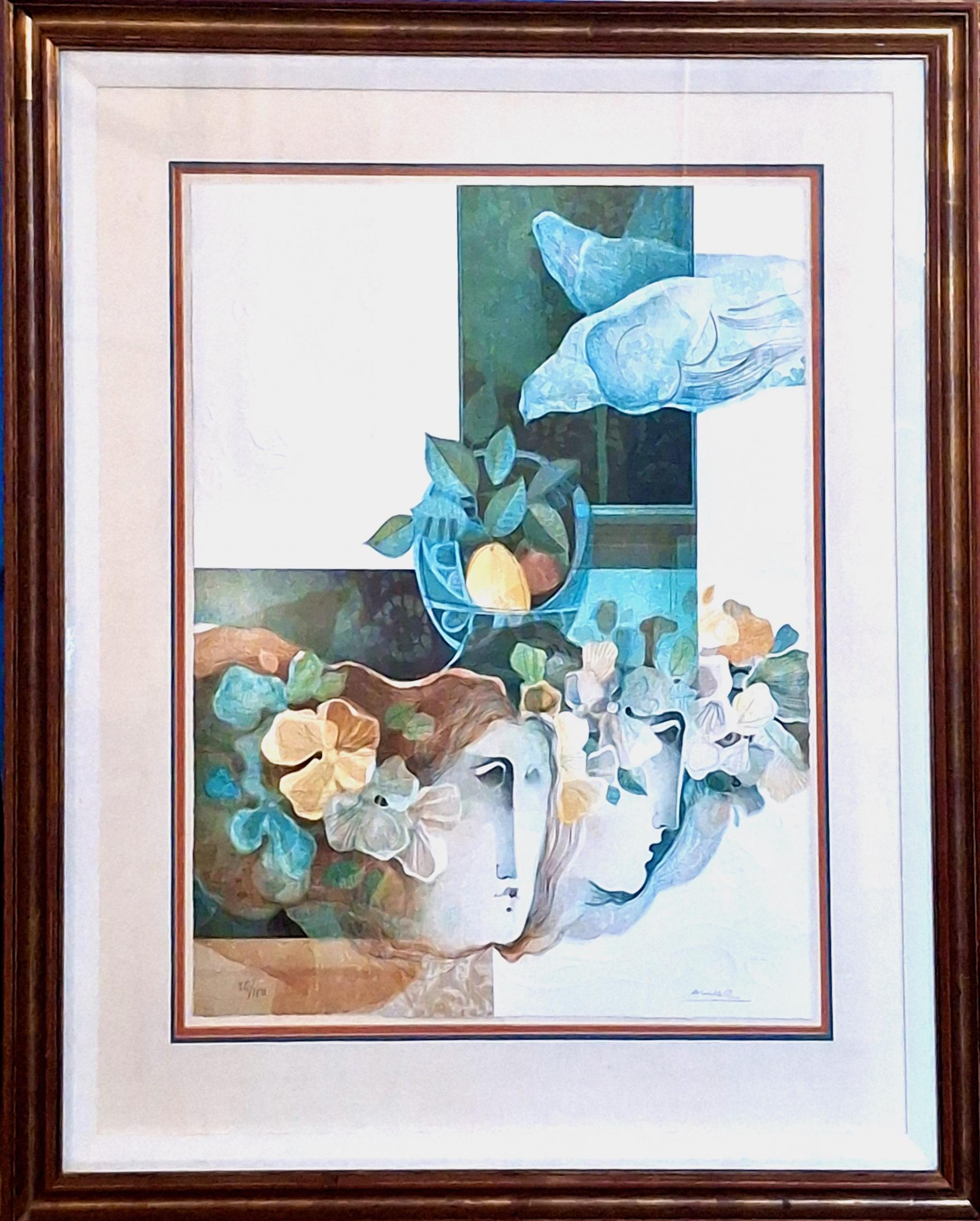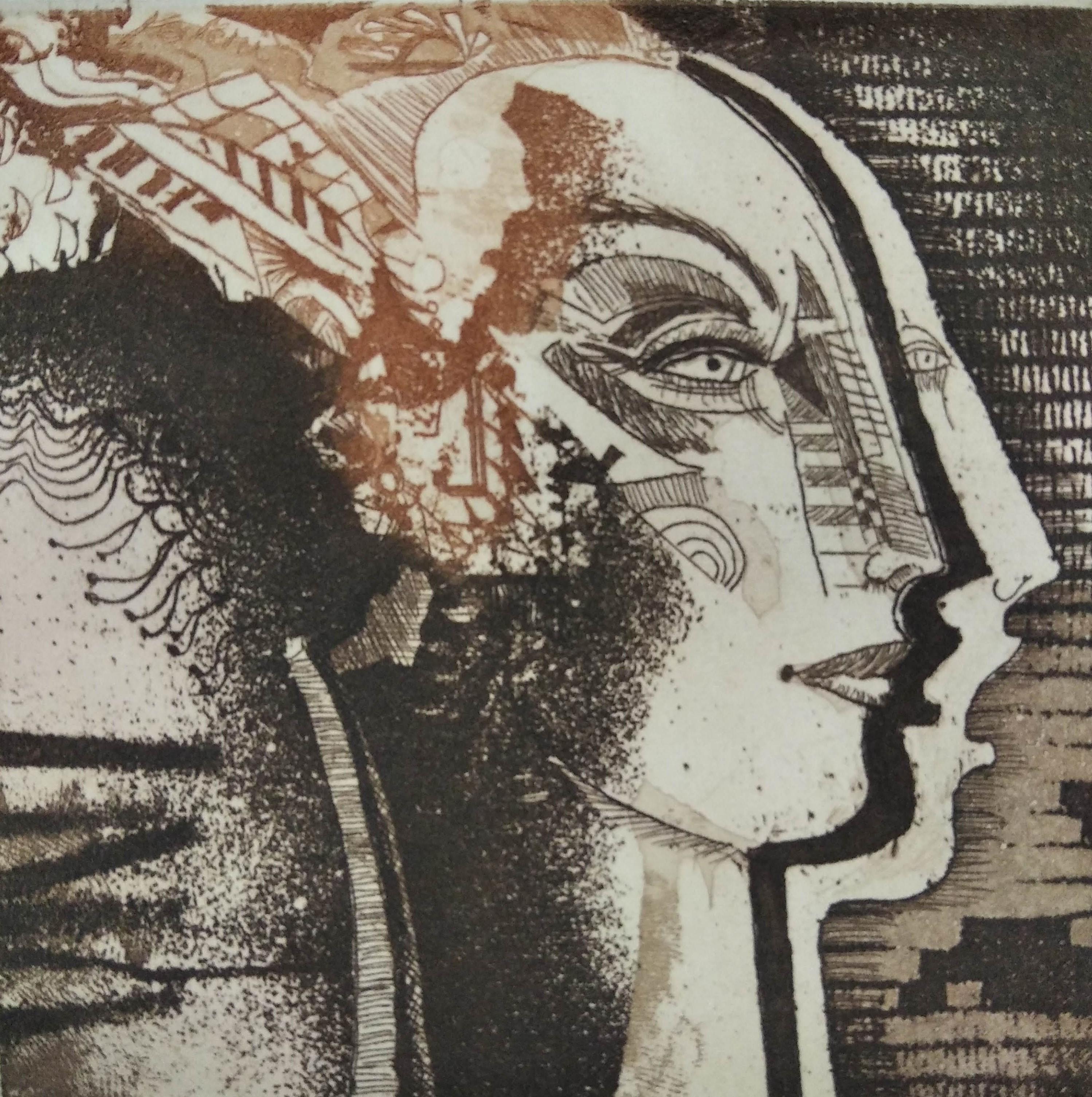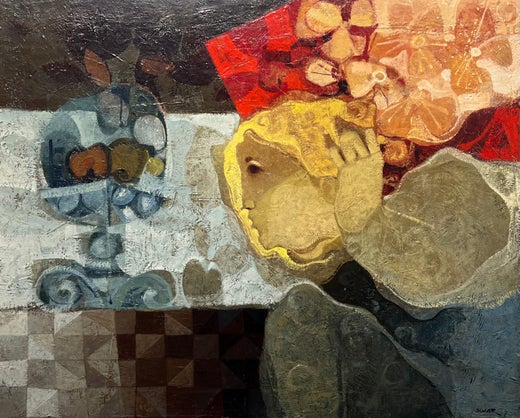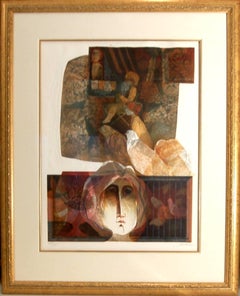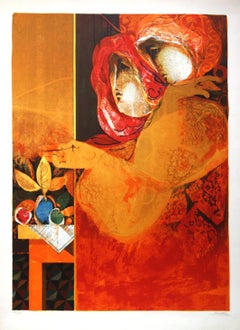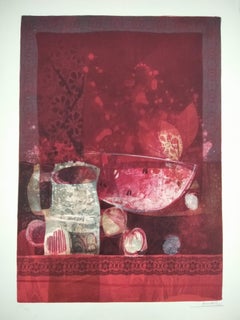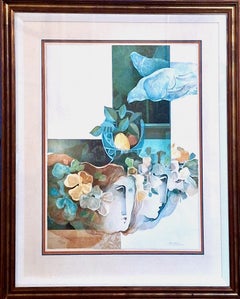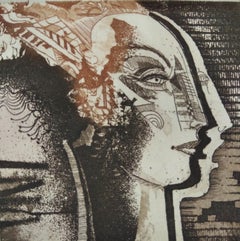Want more images or videos?
Request additional images or videos from the seller
1 of 11
Alvar Sunol Munoz-RamosUntitled IIc. 1970
c. 1970
$1,150
£877.48
€998.20
CA$1,614.97
A$1,767.39
CHF 933.91
MX$21,095.01
NOK 11,917.88
SEK 10,899.87
DKK 7,456.04
About the Item
This artwork "Untitled II" is an original color lithograph with embossing by noted Spanish artist Alvar Sunol Munoz Ramos, b.1935. It is hand signed and numbered 101/260 in pencil by the artist. The image size is 23.75 x 17.75 inches, framed size is 27 x 20.65 inches. Custom framed in a metal gold frame. It is in excellent condition, the frame has some minor scratches.
About the artist:
Alvar Sunol Munoz-Ramos was born on January 20, 1935 in Montgat, a Catalan fishing village on the outskirts of Barcelona, Spain. Sunol Alvar grew up on the sunny Mediterranean coast with his father Tomas, mother Antonia and his older brother and sister, Jordi and Amadea. Showing a great artistic talent as a youth, he attended the Sant Jordi Art School in Barcelona at age 16.
At age 18, he won the "Alhambra de Granada" grant, a summer scholarship that allowed him to travel and paint throughout Spain. This was the birth of Alvar's style and the laying of the technical foundation that would accompany him over the following years. Alvar returned home and entered a painting in competition for the Young Painter's Prize sponsored by the City of Barcelona. He won the Grand Prize and the painting was acquired by the Museum of Modern Art in Barcelona for its permanent collection.
In 1957, at age 22, Alvar gave his first one-man show at the Galleries Layetana in Barcelona. The exhibit was a great success and Alvar received many invitations for shows in other Spanish cities. He entered one of his canvasses for the annual painting competition at the French Institute of Barcelona. He again won the Grand Prize, and with it a study trip to Paris.
Alvar arrived in Paris to paint in 1959. He met Juan Fuentes, a fellow Spaniard and director of the prestigious Gallery Drouant. Fuentes brought Alvar's first group of Paris oil paintings to the gallery. All of the paintings sold in one week. He was subsequently invited to join the celebrated "School of Paris," a group of the top young artists in Paris, organized by the distinguished Charpentier Gallery.
His paintings were exhibited in the United States for the first time at the Monede Gallery, New York city, in 1962. Alvar produced his first original lithographs for a one-man show at Gallery Drouant in 1963. In 1970, Alvar left Paris and returned to Spain.
Sunol Alvar has exhibited regularly throughout the world over the years. His lithographs were honored with an exhibition at the Hyacinth Rigand Museum in Perpignan, France. The Utah Museum of Fine Art, Salt Lake City, Utah and the Wichita Art Museum in Wichita, Kansas have held major exhibits of his lithographs, paintings and sculptures.
- Creator:Alvar Sunol Munoz-Ramos (1935, Spanish)
- Creation Year:c. 1970
- Dimensions:Height: 27 in (68.58 cm)Width: 20.65 in (52.46 cm)Depth: 0.75 in (1.91 cm)
- Medium:
- Movement & Style:
- Period:
- Condition:
- Gallery Location:San Francisco, CA
- Reference Number:Seller: sun/alv/unt/021stDibs: LU66637293732
Alvar Sunol Munoz-Ramos
Alvar Suñol Alvar Suñol Munoz-Ramos, commonly known as Alvar, was born in 1935 in Montgat, Spain, a Catalan fishing village on the Mediterranean coast near Barcelona. By the age of 17, he was accepted into the Escuela Superior de Bellas Artes de San Jorge in Barcelona. In 1960, he moved to Paris and exhibited with other major Spanish artists including Picasso, Miró, and Dalí. Today, Alvar is recognized on an international platform for his exploration of the psychological and historical complexities of art-making and creation in relation to one’s environment and experiences. The examination of both interiors and exterior spaces place a significant role in all of Alvar’s works. Alvar strengthens his artistic vision through the use of various mediums including oil paintings, lithographs, watercolors, drawings, bronzes, and ceramic bas relief sculptures. His works can be found in the permanent collection of over fourteen museums worldwide and he has several public commissions around the world, including his most recent bronze sculpture created in honor of Catalan cellist Pablo Casals that is located in Paris, France. Additionally, Alvar has had three consecutive retrospectives since 2014. His first was hosted at Las Casa de Cultura (The Cultural Center) of Girona, Catalonia, Spain. One year later, Alvar had a second retrospective at the Castell de Benedormiens, in Castell d'Aro, Girona, Spain. Most recently, the Castell de Calonge in Girona, Spain recognized Alvar’s lengthy career from 1954 to 2016 with a retrospective titled, Una Vida Pintant (A Life of Painting). Retrospectives 2016 Una Vida Pintant, 1954-2016, Castell de Calonge, Girona, Spain 2015 Passat i Present,1954-2015, Castell de Benedormiens, Girona, Spain Interiors, Museu de la Mediterrània, Torroella de Montgrí
2014 Alvar Suñol: Una antològica des del 1954-2014, Casa de Cultura de la Diputació de Girona, Girona Spain Museum Shows 2009 Persistències: Exposicio de Dibuixos, Museo de Dibujo Julio Gabin, Castillo de Larrés, Huesca, Spain
2008 Inauguració de l’Escultura, “A Pau Casals” al carrer Pau Casals, Boulogne-Villencourt, Paris, France
2007 Alvar Suñol: Retrospectiva 1954-2008, Museu de Badalona, Barcelona, Spain
The Georgia Center, University of Georgia, Athens, GA Alvar: Contemporary Renaissance, A Retrospective, Albany Museum of Art, Albany, GA Alvar Suñol: A Retrospective, Appleton Museum of Art, Ocala, FL 2003 Realizació de l’escultura “Mediterrània” situada a la Plaça de les Mallorquines, Montgat, Montgat, Spain
2001 Alvar: Huellas en el tiempo, A Retrospective, Instituto Cervantes, Toulouse & Bordeaux, France Lithographs by Alvar, Retrospective, Georgia Museum of Art, Athens, GA 2000 Alvar: Empremptes en el temps, Abadia de Sant Miquel del Fai, Barcelona, Spain 1999 Heullas en el Timpo, Retrospective, Sala Moneo, Ayuntamiento de Logroño Heullas en el Timpo, Retrospective, Centro Cultural Ibercaja, Guadalajara 1997 Empremptes en el temps, Retrospective, Castell de Benedormiens, Castell d’Aro, Girona, Spain
1983 Wichita Museum of Art, Wichita, Kansas
1982 Utah Museum of Fine Art, Salt Lake City
1978 Musée Hyacinthe Rigaud, Perpinyà
About the Seller
5.0
Platinum Seller
Premium sellers with a 4.7+ rating and 24-hour response times
Established in 1999
1stDibs seller since 2017
871 sales on 1stDibs
Typical response time: <1 hour
- ShippingRetrieving quote...Shipping from: San Francisco, CA
- Return Policy
More From This Seller
View AllUntitled
By Alvar Sunol Munoz-Ramos
Located in San Francisco, CA
Featured is a color lithograph by Alvar. Created circa 1970 and numbered 207/225 in pencil by the artist, it is also hand signed by the artist. The artwork features a beautiful contr...
Category
Late 20th Century Modern Figurative Prints
Materials
Lithograph
Untitled III
By Sunol Alvar
Located in San Francisco, CA
Artist: Alvar
Title: Untitled III
Year: c.1990
Medium: Color lithograph with embossing
Edition: Numbered 148/225 in pencil
Paper: Arches
Image size: 16.5 x 22.5 inches
Framed s...
Category
Late 20th Century Romantic Figurative Prints
Materials
Lithograph
From the Barcelona suite
By Sunol Alvar
Located in San Francisco, CA
Artist: Alvar
Title: From Barcelona Suite
Year: 1979
Medium: Color lithograph with embossing
Edition: Numberd 145/185 in pencil
Paper: Arches
Image siz...
Category
1970s Romantic Figurative Prints
Materials
Lithograph
Untitled #1
Located in San Francisco, CA
This artwork, Untitled #1 is an original color aquatint on Wove paper by noted Mexican artist Luis Lopez Loza, b.1939. It is hand signed and numbered 4/50 i...
Category
Late 20th Century Abstract Abstract Prints
Materials
Aquatint
From the, The Barcelona Suite
By Sunol Alvar
Located in San Francisco, CA
Artist: Alvar Sunol Munoz-Ramos (Spanish, born 1935)
Title: From Barcelona Suite
Year: 1979
Medium: Color lithograph with embossing
Edition: Numbered 1...
Category
1970s Romantic Figurative Prints
Materials
Lithograph
Expanding
By Betty Rees Heredia
Located in San Francisco, CA
This artwork titled "Expandingr" 2001 is a original color lithograph on wove paper by American artist Betty Rees Heredia A.K.A Betty Snyder Shapiro,...
Category
Late 20th Century American Modern Abstract Prints
Materials
Lithograph
You May Also Like
Intimations sur La Vie
By Alvar Sunol Munoz-Ramos
Located in Paonia, CO
Intimations sur la Vie.. from Le Miracle Quotidien suite 1974
Original signed lithograph
Edition no. 132/225
paper size 40 x 30
image size 33.50 x 24
condition ...
Category
1970s Expressionist Figurative Prints
Materials
Lithograph
Untitled
By Alvar Sunol Munoz-Ramos
Located in Barcelona, BARCELONA
The painting is being offered with a work and authenticity certificate
Category
1980s Abstract Abstract Prints
Materials
Lithograph
From “The Four Seasons Suite” Series
By Alvar Sunol Munoz-Ramos
Located in San Francisco, CA
This hand-signed, limited-edition lithograph with embossing is by the renowned Catalan Modernist artist Alvar Suñol Muñoz-Ramos, commonly known as Alvar. Part of “The Four Seasons” s...
Category
1970s Modern Figurative Prints
Materials
Paper, Lithograph
Untitled
Located in Barcelona, BARCELONA
Includes a Certificate of Authenticity
Category
1990s Post-Modern Portrait Prints
Materials
Engraving
Untitled
Located in Barcelona, BARCELONA
The painting is being offered with a work and authenticity certificate
Category
1980s Abstract Abstract Prints
Materials
Engraving
Untitled
Located in Barcelona, BARCELONA
Includes a Certificate of Authenticity
Category
1990s Post-Modern Portrait Prints
Materials
Engraving
More Ways To Browse
Dali Hippocrates
Dali Horseman
Dali Illustrates Casanova
Dali Man Of La Mancha
Dali Othello
Dali Pig And Pepper
Dali Purgatory Signed
Dali Saba
Dali Signed Ecstatic
Dali Skeleton
Dali Spinning Man
Dali The Annunciation
Dali Thus Was Earth Created
Dame Laura Knight On Sale
Danos Flower Shop
Daumier Actualites
David Ham
David Schluss Serigraph
